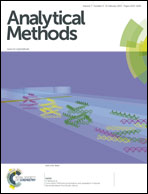Cathodic electrochemiluminescence of a CdSe/ZnS QDs-modified glassy carbon electrode and its application in sensing of Pb2+
Abstract
This paper reports the electrochemiluminescence (ECL) behavior of CdSe/ZnS with K2S2O8 as the coreactant. The effects of pH, K2S2O8 concentration, the duration of the reaction of 4-ATP with GCE and the duration of the reaction of 4-ATP/GCE with QDs on ECL intensity were studied in detail. A possible ECL reaction mechanism was then proposed. In addition, it was observed that the ECL intensity was efficiently quenched by trace amounts of heavy metal ion. Based on the quenching effect of Pb2+ upon the ECL of CdSe/ZnS QDs, a QDs-ECL sensor was constructed to detect Pb2+ in preserved duck egg. The sensor showed good reproducibility and stability.


 Please wait while we load your content...
Please wait while we load your content...